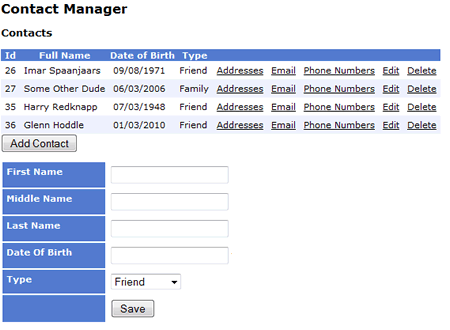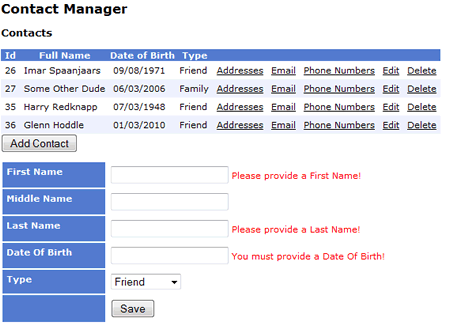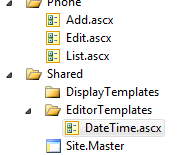MVC2.0的RTM版本终于在2010年3月11日推出,借此,我也为我的Contact Manager application增加一些新的特性。尽管本篇文章主要关注使用DataAnnotations来对model进行验证,但我也会对最新版本特性进行简单的接触。
在开始之前,我不得不说明我已经安装了VS 2010 RC1,并使用它将老版本转换为ASP.Net 4.0(老版本可以点击这里下载)
大多数情况下,当你接收到来自用户从form表单post来的信息后,你的验证代码往往会检查相应的值是否存在,数据类型是否正确以及数据的范围是否正确。至少,你应该保证每当一个函数接受用户输入时,就应该执行相应的验证逻辑。这意味着有些时候在整个程序中的不同位置,你会对同一个或者相似的值进行多次验证。比如说你想限制用户的姓氏不大于20个字符,那这样的验证需要在程序的好几个部分实现。直到Jan Vennegoor of Hesselink的出现(荷兰球队的一名球员,目前为doomed Hull City FC效力),在他的薪水还没有随着他服役的球队被降级以前,他来到你的网站想购买一个价值50,000英镑的耳环,他以他22个字符长度的姓氏注册,但他发现他的姓氏不在允许的范围之内时,他很气愤的离开你的网站并且给web master留下不满的评论。很明显,你可不想让类似的情况出现,所以你不得不在你的程序中找到所有验证姓氏长度的相关代码,并一一修正以便能接受更长的姓氏……
如果将验证代码放到一个集中的地方时,那类似上面所说的改变会不会变得更简单些?Model中的DataAnnotations正是为此而来,在MVC2.0中,这一特性被包含在内。
DataAnnotations作为.net Framework的一部分已经有一段时间了,但是MVC2.0中增加了ModelMetaData类,这是储存MetaData的容器,默认会使用同样也是新增类的DataAnnotationsMetaDataProvider类。因为传入的值会由Action方法接受model binding作为匹配传入参数和action的参数而介入,在MVC2.0中,默认的model binder使用DataAnnotationsMetaDataProvider来获取metadata中model binder尝试匹配的对象,如果验证用的metadata存在,则其会通过对对象的属性和传入的值比较来进验证,这类meta由你通过使用标签(Attribute)修饰属性来实现。
下面例子中我通过原程序中添加联系人这一过程来描述使用DataAnnotatioins的方法,这里我们使用自定义ViewModel,名为:ContactPersonViewModel。通过Contact.Add()这个action方法来添加联系人,代码如下:
using System; using System.Collections.Generic; using System.Web.Mvc; using System.ComponentModel; namespace ContactManagerMVC.Views.ViewModels { public class ContactPersonViewModel { public int Id { get; set; } public string FirstName { get; set; } public string MiddleName { get; set; } public string LastName { get; set; } public DateTime DateOfBirth { get; set; } public IEnumerable<SelectListItem> Type { get; set; } } }
下面,我在为属性添加一些标签(Attribute):
using System; using System.Collections.Generic; using System.Web.Mvc; using System.ComponentModel.DataAnnotations; using ContactManagerMVC.Attributes; using System.ComponentModel; namespace ContactManagerMVC.Views.ViewModels { public class ContactPersonViewModel { public int Id { get; set; } [Required(ErrorMessage = "Please provide a First Name!")] [StringLength(25, ErrorMessage = "First name must be less than 25 characters!")] [DisplayName("First Name")] public string FirstName { get; set; } [DisplayName("Middle Name")] public string MiddleName { get; set; } [Required(ErrorMessage = "Please provide a Last Name!")] [StringLength(25, ErrorMessage = "Last name must be less than 25 characters!")] [DisplayName("Last Name")] public string LastName { get; set; } [Required(ErrorMessage = "You must provide a Date Of Birth!")] [BeforeTodaysDate(ErrorMessage = "You can't add someone who hasn't been born yet!")] [DisplayName("Date Of Birth")] public DateTime? DateOfBirth { get; set; } public IEnumerable<SelectListItem> Type { get; set; } } }
上面标签的绝大多数标签都是在System.ComponentModel.Annotations命名空间内,只有RequiredAttribute标签不在此命名空间内,这个标签声明此值必须是一个有效值,并且包含ErrorMessage属性。这个属性可以让你传入自定义错误信息。StringLengthAttribute标签指定了属性可以接受的最小值和最大值范围。当和RequiredAttribute标签结合使用时,只需要设置可以接受的最大值。DisplayNameAttribute用于设置属性如何显示.
上面标签中BeforeTodaysDateAttribute标签并不是.net Framework所提供,这是一个自定义标签,用于检测日期是否比当前的日期要早,你可以看到ErrorMessage值被设置。这个标签用于防止任何被添加到联系人列表的联系人还未出生-.-!!,下面是这个标签的代码:
using System.ComponentModel.DataAnnotations; using System; namespace ContactManagerMVC.Attributes { public class BeforeTodaysDateAttribute : ValidationAttribute { public override bool IsValid(object value) { if (value == null) { return true; } DateTime result; if (DateTime.TryParse(value.ToString(), out result)) { if (result < DateTime.Now) { return true; } } return false; } } }
很简单是吧,这个类继承了ValidationAttribute并重写了IsValid()虚方法,如果未提供值,或是值小于当前日期(DateTime.Now),则返回True.
利用标签(Attribute)的方式让在一个集中的地方应用验证规则变得简单,现在,只要ContactPersonViewModel在程序中被用到了,则验证规则同时也会被应用到。这常常如此(http://www.asp.net/learn/mvc/tutorial-39-cs.aspx),但现在DefaultModelBinder内的DataAnnotations被支持,下面来看新版本的Add Partial View:
<%@ Control Language="C#" Inherits="System.Web.Mvc.ViewUserControl<ContactPersonViewModel>" %> <script type="text/javascript"> $(function() { $('#DateOfBirth').datepicker({ dateFormat: 'yy/mm/dd' }); }); $('#save').click(function () { $.ajax({ type: "POST", url: $("#AddContact").attr('action'), data: $("#AddContact").serialize(), dataType: "text/plain", success: function (response) { if (response == "Saved") { window.location = "/"; }else { $("#details").html(response); } } }); }); </script> <% using (Html.BeginForm("Add", "Contact", FormMethod.Post, new { id = "AddContact" })) {%> <table> <tr> <td class="LabelCell"><%= Html.LabelFor(m => m.FirstName)%> </td> <td><%= Html.TextBox(m => m.FirstName)%> <%= Html.ValidationMessageFor(m => m.FirstName)%></td> </tr> <tr> <td class="LabelCell"><%= Html.LabelFor(m => m.MiddleName)%> </td> <td><%= Html.TextBox(m => m.MiddleName)%></td> </tr> <tr> <td class="LabelCell"><%= Html.LabelFor(m => m.LastName)%> </td> <td><%= Html.TextBox(m => m.LastName)%> <%= Html.ValidationMessageFor(m => m.LastName)%></td> </tr> <tr> <td class="LabelCell"><%= Html.LabelFor(m => m.DateOfBirth)%> </td> <td><%= Html.TextBox(m => m.DateOfBirth)%> <%= Html.ValidationMessageFor(m => m.DateOfBirth)%></td> </tr> <tr> <td class="LabelCell"><%= Html.LabelFor(m => m.Type)%></td> <td><%= Html.DropDownList("Type")%> </td> </tr> <tr> <td class="LabelCell"></td> <td><input type="button" name="save" id="save" value="Save" /></td> </tr> </table> <% } %>

可以看出,这里使用新的强类型Html Helper.对前面项目修改的两处是利用了jQuery代码。第一处是添加联系人的Partial View是通过AJax提交,如果验证失败,则添加的form会再次被显示,如果验证通过,新的联系人被添加到列表中,页面会刷新继而显示更新后包含新联系人的列表。下面来看如果不输入任何日期时点击Save按钮的效果:

由于下面几种原因,原来的Action方法需要被修正。首先修改action方法使其接受ContactPersonViewModel而不是ContactPerson作为参数,这是因为相关的验证规则应用于ContactPersonViewModel,如果不将参数类型改变,那model binder依然能将传入的值和ContactPerson的属性相匹配,但所有的验证规则就不复存在了。第二个改变是检查ModelState的IsValid属性是否有效,否则整个验证就变得毫无意义.
[AcceptVerbs(HttpVerbs.Post)] public ActionResult Add([Bind(Exclude = "Id, Type")]ContactPersonViewModel person) { if (ModelState.IsValid) { var p = new ContactPerson { FirstName = person.FirstName, MiddleName = person.MiddleName, LastName = person.LastName, Type = Request.Form["Type"].ParseEnum<PersonType>() }; if (person.DateOfBirth != null) p.DateOfBirth = (DateTime)person.DateOfBirth; ContactPersonManager.Save(p); return Content("Saved"); } var personTypes = Enum.GetValues(typeof(PersonType)) .Cast<PersonType>() .Select(p => new { ID = p, Name = p.ToString() }); person.Type = new SelectList(personTypes, "ID", "Name"); return PartialView(person); }
在model绑定过程中,我去掉了id和Type属性,因为在把联系人添加到数据库以前并不会存在id属性,而去掉Type属性是因为在ViewModel中它的类型是SelectList,但在BLL层中ContactPerson对象中却是枚举类型,如果ModelState的IsValid属性为True(注:既验证通过),则ViewModel的属性会和ContactPerson对象的属性进行匹配,如果IsValid不为True,数据会回传到View中显示验证失败的相关信息。
上面代码中我们注意到了Request.Form[“Type”]这个string类型的ParseEnum<T>扩展方法,这也是为什么我去掉Type属性,只有这样它才会被转换为适当的类型。扩展方法的原型(在我的Google Analytics 文中)如下:
public static T ParseEnum<T>(this string token) { return (T)Enum.Parse(typeof(T), token); }
edit这个action方法也是如此,除了对DateOfBirth进行编辑那部分:
<tr> <td class="LabelCell"><%= Html.LabelFor(m => m.DateOfBirth)%> </td> <td><%= Html.EditorFor(m => m.DateOfBirth)%> <%= Html.ValidationMessageFor(m => m.DateOfBirth)%></td> </tr>
这里我并没有使用TextBoxFor<T>扩展方法,而是使用了EditorFor<T>方法,默认情况下,DateTime类型都以hh:mm:ss这样的方式显示,但我并不喜欢这种格式,所以我创建了一个格式化显示时间日期的模板,在View/Shared目录下,我添加了一个名为EditorTemplates(这也是MVC中应有命名方式,因为MVC会自动搜索这个位置)并在此目录下添加一个名为DateTime的Partial View,这也是MVC的惯例,如图:

而DateTime.ascx的代码如下:
<%@ Control Language="C#" Inherits="System.Web.Mvc.ViewUserControl<System.DateTime?>" %> <%= Html.TextBox("", Model.HasValue ? Model.Value.ToShortDateString() : string.Empty) %>
虽然只有短短两行代码,但是可以让时间日期如果为空时,什么都不显示,而如果时间存在,则以ShortDate的格式显示。
总结
本篇文章研究了ASP.Net MVC 2.0中利用DataAnnotations来进行验证,现在这已经是.net framework的一部分。文中还简单的接触了新版本中的一些特性,包括强类型的HTML Helper以及模板。本篇文章的代码使用VS 2010RC1创建的,所以代码不能在VWD 和 VS的环境中调试。
联系人程序在添加了额外的验证功能后进一步升级,但离完成还遥遥无期,在未来的文章中,我会继续更新这个程序。
------------------------------
原文链接:Validating the Contact Manager with MVC 2.0 And VS 2010
translated byCareySon